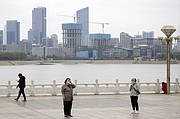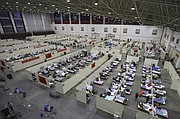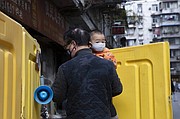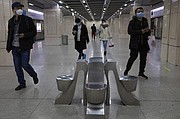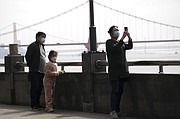Virus data: What's known and not known about China's numbers
Ken Moritsugu | Hagadone News Network | UPDATED 5 years, 9 months AGO
BEIJING (AP) — Every few days brings another grim milestone in the coronavirus outbreak. First Italy and Spain surpassed China in reported deaths. Then, this week, the U.S. and France did.
But did they really?
Skepticism about China's numbers has swirled throughout the crisis, fueled by official efforts to quash bad news in the early days and a general distrust of the government. Long lines of people waiting to collect the ashes of loved ones at funeral homes last week revived the debate.
There is no smoking gun pointing to a cover-up by China's ruling Communist Party. But intentional or not, there is reason to believe that more people died of COVID-19 than the official tally, which stood at 3,312 at the end of Tuesday. The same applies to the 81,554 confirmed cases, now exceeded by the U.S., Italy and Spain.
The health system in Wuhan, the city where three-fourths of China's victims died, was overwhelmed at the peak of the outbreak. Hospitals overflowed, patients with symptoms were sent home and there weren't enough kits to test everyone. In any country, getting a complete picture in the fog of war is virtually impossible.
“The number of confirmed cases of COVID-19 by country appears like a grim league table and draws the attention of many," said Hsu Li Yang, who heads the infectious diseases program at the National University of Singapore. “However, it is important to understand that these numbers – be it from China, Italy, Singapore or the U.S.A. – are all inaccurate, and they are all underestimates to varying degrees of the actual number of infections."
DEATHS: THE FUNERAL URNS
China scrambled hard in late January to handle the spiraling number of infected people and test them. On some days, it reported more new suspected cases — those who had symptoms but had not yet been tested — than confirmed ones.
Those who died before they were tested never made it into the official death tally. Just how many is unclear. An unidentified doctor told Caixin, a Chinese magazine, that the death toll for suspected cases at the doctor's hospital was almost as high as for confirmed ones over a 20-day period.
Others died at home before they were tested, since hospitals didn't have enough beds to admit them.
At the time, some people in China asked on social media whether the reported death toll was inaccurate for those reasons. The posts have been deleted, probably victims of censorship.
A few posts raised the question again last week after online images showed people in Wuhan lining up for hours to collect the ashes of relatives and anecdotal media reports that thousands of urns were being delivered to funeral homes. As of the end of Tuesday, the city's coronavirus death toll was 2,553.
The city, which is gradually easing virus-control restrictions that have kept residents from moving around for two months, began allowing ashes to be collected in time for an upcoming holiday when people tend to relatives' graves.
One social media post asked the government to publish how many people die on average in the city and how many have died this year to give a better reckoning of victims.
Even without the virus, several thousand die every month in the city of 11 million people. From January to March last year, 14,700 bodies were cremated in Wuhan, according to quarterly data posted online.
The city also diverted most of its medical resources to fighting the virus, leaving some other sick people without care. Early in the crisis, one woman told The Associated Press a relative died after a long wait for an ambulance. She couldn't say for sure that caused his death, but more people may have died than usual from other causes because they couldn't get treated.
Exactly how many died from the coronavirus may never be known.
INFECTIONS: WHEN ZERO IS NOT ZERO
For the last two weeks, Wuhan has reported no new cases almost every day. It's a remarkable decline from the thousands it reported every day until mid-February, and the hundreds into early March.
But China decided early to stop including in its count those who test positive for the virus but don't have any symptoms. The World Health Organization asks member countries to report asymptomatic lab-confirmed cases, though most with big outbreaks don''t have the testing capacity to identify them.
“If they are known to be positive and they have no symptoms, then yes, they should be counted," said Ian Mackay of Australia’s University of Queensland who studies viruses.
As Wuhan began reporting zero new cases, online posts said a case had been found. In fact, it was an asymptomatic case, and the Wuhan government said it didn't meet the definition of a confirmed case.
Identifying cases of COVID-19 is more difficult than deaths, because many of the infections are mild or asymptomatic and not tested, Hsu said.
The number of asymptomatic cases depends on how intensively a country tests people. South Korea curbed a sizable outbreak, one of the first outside China, by aggressively tracking down anyone who had come in contact with a confirmed case, and testing and isolating them if their test was positive. As a result, the proportion of asymptomatic infections in its now nearly 10,000 cases was much higher than elsewhere, South Korea's Centers for Disease Control has said.
In China's case, it may not have found many asymptomatic cases at the start because it was struggling just to test everyone with symptoms. That's similar to anywhere with a major outbreak. The U.S. has refused tests for some people without symptoms as it races to find enough test kits for those who do.
Now, asymptomatic cases — and the risk they present — are coming to the fore as China eases restrictions on movement to get the economy started again. The fear is cases like a woman in Henan province, north of Wuhan, who developed a fever and was diagnosed with COVID-19 last weekend after she had visited a friend who had no symptoms but later tested positive.
Scientists are divided on whether asymptomatic cases may be driving transmission but say it’s important to track every case near the end of an outbreak to prevent flare-ups.
China began releasing the number of asymptomatic cases for the first time this week, though still not including them in the confirmed case count. As of the end of Tuesday, it had 1,367 such cases under medical observation.
Some develop symptoms and become confirmed cases. The others never make it into the total.
CREDIBILITY GAP
Seventeen years ago, China tried to cover up the extent of the SARS ourbreak, another coronavirus that spread beyond its borders. The government is being far more open this time, but it can't shake the distrust at home and abroad.
“The Chinese government has been taking an open, transparent and responsible attitude all along and publishing the latest figures to the world every day," Foreign Ministry spokeswoman Hua Chunying said Wednesday.
It's not just epidemics. The public has long distrusted Chinese officials who have a track record of lying and suppressing information about industrial and natural disasters, toxic consumer products and health crises.
Overseas researchers have long been skeptical of Chinese economic reports that show high and unusually stable growth for a developing country, The economy might be up to 21% smaller than official data indicate, according to a 2018 study by Yingyao Hu and Jiaxiong Yao of Johns Hopkins University.
China has played up the efforts of the Communist Party and the sacrifices of medical workers to tackle the crisis, while suppressing reports about hospital overcrowding and reprimanding medical workers for rumor-mongering after they tried to raise the alarm about the emergence of a possible new disease. It's a formula that invites skepticism, whether the government is telling the truth or not.
___
Associated Press writers Kim Tong-hyung in Seoul, South Korea, and Aniruddha Ghosal in New Delhi contributed.
—-
Follow AP news coverage of the coronavirus pandemic at https://apnews.com/VirusOutbreak and https://apnews.com/UnderstandingtheOutbreak
ARTICLES BY KEN MORITSUGU
China both worries and hopes as US departs Afghanistan
BEIJING (AP) — In the U.S. departure from Afghanistan, China has seen the realization of long-held hopes for a reduction of the influence of a geopolitical rival in what it considers its backyard.
China both worries and hopes as US departs Afghanistan
BEIJING (AP) — In the U.S. departure from Afghanistan, China has seen the realization of long-held hopes for a reduction of the influence of a geopolitical rival in what it considers its backyard.
China both worries and hopes as US departs Afghanistan
BEIJING (AP) — In the U.S. departure from Afghanistan, China has seen the realization of long-held hopes for a reduction of the influence of a geopolitical rival in what it considers its backyard.











